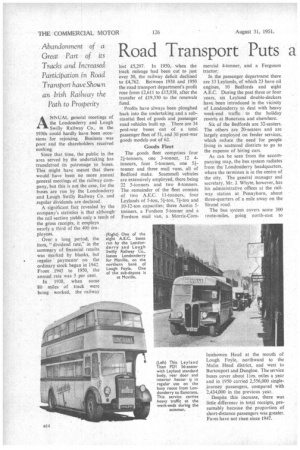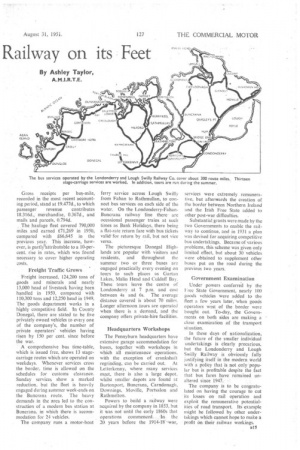Road Transport Puts a Railway on its Feet
Page 48

Page 49

If you've noticed an error in this article please click here to report it so we can fix it.
By Ashley Taylor, ANNUAL general meetings of the Londonderry and Lough Swilly Railway Co., in the 1930s could hardly have been occasions for rejoicing. Business was poor and the shareholders received nothing.
Since that time, the public in the area served by the undertaking has transferred its patronage to buses. This might have meant that there would have been no more annual general meetings of the railway company, but this is not the case, for the buses are run by the Londonderry and Lough Swilly Railway Co. and regular dividends are declared.
Over a long period, the item, 'dividend rate," in the summary of financial results was marked by blanks, but • regular . payments' on the ordinary stock began in 1942. From 1945 to 1950, the annual rate was 5 per cent. In 1938, . when some 80 miles of track were being worked, the railway lost £5,297. In 1950, when the track mileage had been cut to just over 30, the railway deficit declined to £4,762. Between 1938 and 1950 the road transport department's profit rose from £2,611 to £15,938, after the transfer of £19,330 to the renewals fund.
Profits have always been ploughed back into the undertaking and a substantial fleet of goods and passenger road vehicles built up. There are 34 post-war buses out of a total passenger fleet of 51, and 30 post-war goods models out of 62.
Goods Fleet
The goods fleet comprises four 2i-tonners, one 3-tonner, 12 4tonners, four, 5-tonners, one 5/tonner and three mail vans, all of Bedford make. Scammell vehicles are extensively employed, there being 22 5-tonners and two 13-tonners. The rentainder of the fleet consists of two AEC. 11-tonners, four Leylands of 5-ton, 5i-ton, 7i-ton and 10-12-ton capacities; three Austin 5tonners, a Fordson 5-tanner and a Fordson mail van, a Morris-Corn
mercial 4-tonner, and a Ferguson tractor.
In the passenger department there are 33 Leylands, of which 23 have oil engines, 10 Bedfords and eight A.E.C. During the past three or four years, six Leyland double-deckers have been introduced in the vicinity of Londonderry to deal with heavy week-end traffic to the holiday resorts at Buncrana and elsewhere.
Six of the Bedfords are 32-seaters. The others are 20-seaters and are largely employed on feeder services, which reduce the need" for people living in scattered districts to go to the expense of hiring cars.
As can be seen from the accompanying map, the bus system radiates from the Londonderry headquarters, where the terminus is in the centre of the city. The general manager and secretary, Mr. J. Whyte, however, has his administrative offices at the railway station at Pennyburn, about three-quarters of a mile away on the Strand road.
The bus system covers some 300 route-miles, going north-east to Inishowen Head at the mouth of Lough Foyle, northward to the Malin Head district, and west to Burtonport and Dungloe. The service buses cover about urn. miles a year and in 1950 carried 2,556,000 singlejourney passengers, compared with 2,434,000 in the previous year.
Despite this increase, there was little difference in total receipts, presumably because the proportion of short-distance passengers was greater. Fares have not risen since 1947. Gross receipts per bus-mile, recorded in the most recent accounting period, stand at 19.477d., to which passenger revenue contributes 18.316d., merchandise, 0.367d., and mails 'and parcels, 0.794d.
The ,haulage fleet covered 790,000 miles and earned 01,269 in 1950, compared with £66,645 in the previous year. This increase, however, is partly.attributable to a 10-percent. rise in rates, which was found necessary to cover higher operating costs,
Freight Traffic Crows
Freight increased, 124,200 tons of goods and minerals and nearly 13,000 head of livestock having been handled in 1950, compared with 110,300 tons and 12,250 head in 1949. The goods department works in a highly competitive field. In County Donegal, there are stated to be five privately owned vehicles to every one of the company's, the number of private operators' vehicles having risen by 150 per cent. since before the war.
A comprehensive bus time-table, which is issued free, shows 13 stagecarriage routes which are operated on weekdays. Whenever services cross the border. time is allowed on the schedules for customs clearance. Sunday services show a marked reduction, but the fleet is heavily engaged during summer week-ends on the Buncrana route. The heavy demands in the area led to the construction of a modern bus station at Buncrana, in which there is accommodation for 24 vehicles.
The company runs a motor-boat ferry service across Lough Swilly from Fahan to Rathmullan, to connect bus services on each side of the water. On the Londonderry-FahanBuncrana railway line there are occasional passenger trains at such times as Bank Holidays, there being a flat-rate return fare with bus tickets valid' for return by rail, but not vice versa.
The picturesque Donegal Highlands are popular with visitors and residents, and throughout the summer two or three buses are engaged practically every evening on tours to such places as Gartan Lakes, MaiM Head and Culdaff Bay. These tours leave the centre of Londonderry at 7 p.m. and cost between 4s and 6s. The average distance covered is about 70 miles. Longer afternoon tours are operated when there is a demand, and the company offers private-hire facilities.
Headquarters Workshops The Pennyburn headquarters have extensive garage accommodation for buses, together -with workshops in which all maintenance operations, with the exception of crankshaft regrinding, can be carried out. At Letterkenny, where many services meet, there is also a large depot, whilst smaller depots are found at Burtonport, Buncrana, Carndonagh, Downings, Moville, Portsalon and Rathmelton.
Powers to build a railway were acquired by the company in 1853, but it was not until the early 1860s that operations commenced. •In., the 20 years before the 19144W-war, services were extremely remunerative, but afterwards the creation of the border between Northern Ireland and the Irish Free State added to other post-war difficulties. .
Substantial grants were made by the two Governments to enable the railway to continue, and in 1931 a plan was devised for acquiring competitive bus undertakings. Because of various problems, this scheme was given only limited effect, but about 30 vehicles were obtained to supplement other buses put on the road during the previous two years.
Government Examination
Under powers conferred by the Free State Government, nearly 100 goods vehicles were added to the fleet a few years later, when goods operators west of the border were bought out. To-day, the Governments on both sides are making a close examination of the transport situation.
In these days of nationalization, the future of the smaller individual undertakings is clearly precarious, but the Londonderry and Lough Swilly Railway is obviously fully justifying itself in the modern world with a policy that is not only 'popular but is profitable despite the fact that bus fares have remained unaltered since 1947.
The company is to be congratulated on having the courage to cut its losses on rail operation and exploit the remunerative potentialities of road transport. Its example rnight be followed by other undertakings which-cannot hope to make a profit On.-their railway workings.




















































































